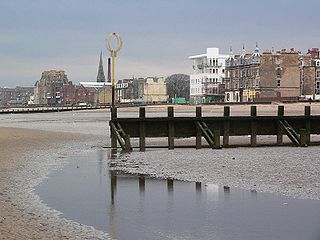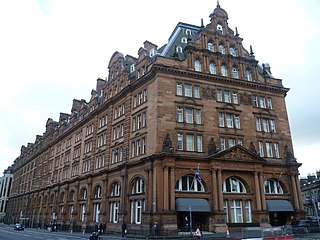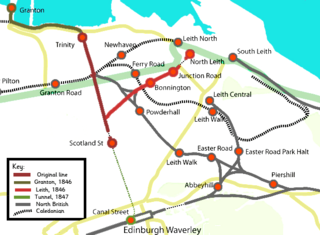Related Research Articles

Leith is a port area in the north of the city of Edinburgh, Scotland, founded at the mouth of the Water of Leith. It was recently ranked as one of the top five neighbourhoods to live in the world.

The Caledonian Railway (CR) was a major Scottish railway company. It was formed in the early 19th century with the objective of forming a link between English railways and Glasgow. It progressively extended its network and reached Edinburgh and Aberdeen, with a dense network of branch lines in the area surrounding Glasgow. It was absorbed into the London, Midland and Scottish Railway in 1923. Many of its principal routes are still used, and the original main line between Carlisle and Glasgow is in use as part of the West Coast Main Line railway.

Edinburgh Trams is a tramway in Edinburgh, Scotland, operated by Edinburgh Trams Ltd. As of 2017 it is a 14-kilometre (8.7 mi) line between York Place in the New Town and Edinburgh Airport, with 16 stops.

Portobello is a coastal suburb of Edinburgh in eastern central Scotland. It lies 3 miles (5 km) east of the city centre, facing the Firth of Forth, between the suburbs of Joppa and Craigentinny. Although historically it was a town in its own right, it is officially a residential suburb of Edinburgh. The promenade fronts onto a wide sandy beach.

The Melbourne cable tramway system was a cable car public transport system, which operated between 1885 and 1940 in Melbourne, Victoria, Australia.

This article is a timeline of the history of Edinburgh, Scotland, up to the present day. It traces its rise from an early hill fort and later royal residence to the bustling city and capital of Scotland that it is today.

The Sydney tramway network served the inner suburbs of Sydney, Australia from 1879 until 1961. In its heyday, it was the largest in Australia, the second largest in the Commonwealth of Nations, and one of the largest in the world. The network was heavily worked, with about 1,600 cars in service at any one time at its peak during the 1930s . Patronage peaked in 1945 at 405 million passenger journeys. Its maximum street trackage totalled 291 km in 1923.

Edinburgh is a major transport hub in east central Scotland and is at the centre of a multi-modal transport network with road, rail and air communications connecting the city with the rest of Scotland and internationally.

Princes Street Station was a mainline railway station which stood at the west end of Princes Street, in Edinburgh, Scotland, for almost 100 years. Temporary stations were opened in 1848 and 1870, with construction of the main station commencing in the 1890s. The station was closed completely in 1965 and largely demolished in 1969–70. Only its hotel remains, but it is no longer in railway ownership.
The Edinburgh Suburban and Southside Junction Railway was a railway company that built an east-west railway on the southern margin of Edinburgh, Scotland, primarily to facilitate the operation of heavy goods and mineral traffic across the city. The line opened in 1884. Although its route was rural at the time, suburban development quickly caught up and passenger carryings on the line were buoyant; the passenger service operated on a circular basis through Edinburgh Waverley railway station.

Leith Walk is one of the longest streets in Edinburgh, Scotland, and is the main road connecting the port area of Leith to the centre of the city. Forming the majority of the A900 road, it slopes upward from 'the Foot of the Walk' at the north-eastern end of the street, where Great Junction Street, Duke Street and Constitution Street meet, to the Picardy Place roundabout at the south-western end.
Edinburgh Corporation Tramways formerly served the City of Edinburgh, Scotland. The city used four-wheeled double-decked trams painted dark red (madder) and white – a livery still used by Lothian Buses and the post-2014 Edinburgh Trams.

The Edinburgh, Leith and Newhaven Railway was a railway company formed in 1836 to connect the city of Edinburgh with the harbours on the Firth of Forth. When the line connected to Granton, the company name was changed to the Edinburgh, Leith and Granton Railway. It opened part of its route in 1846, but reaching the centre of Edinburgh involved the difficult construction of a long tunnel; this was opened in 1847. It was on a steep incline and was worked by rope haulage.
Trams operated in Edinburgh from 1871 to 1956, and resumed in 2014. The first systems were horse-drawn, while cable-haulage appeared in the city in 1888. Electric trams first ran on systems in neighbouring Musselburgh (1904) and Leith (1905), meeting the Edinburgh cable-trams at Joppa and Pilrig respectively. Electrification meant cable trams last ran in 1923, with through running now possible to Leith and as far east as Port Seton. The various systems were operated by different private and municipal entities over the years; the Edinburgh and Leith systems had been merged under Edinburgh Corporation by 1920, but it wasn't until 1928, after the partial closure of Musselburgh line, that all trams operating in Edinburgh were in the sole control of the corporation. The last electric trams ran in 1956, but electric trams returned in 2014 with the opening of Edinburgh Trams. Many of the trams from the horse/cable/first electric era were built in Shrubhill Works. Two trams have been preserved, a horse tram and an electric tram, built by Shrubhill in 1885 and 1948 respectively. A 1903 Dick Kerr cable-tram has also been purchased for preservation. Remnants of the cable-tram system can be seen in Waterloo Place and Henderson Row, and of the Musselburgh line at Morrison's Haven.

Leith Corporation Tramways operated a passenger tramway service in Leith between 1904 and 1920.
Edinburgh Street Tramways operated a horse-drawn tramway service in Edinburgh between 1871 and 1896, and Leith between 1871 and 1904.
The Caledonian Railway lines to Edinburgh started with the main line that reached Edinburgh in 1848 as part of its route connecting the city with Glasgow and Carlisle. The potential of the docks at Granton and Leith led to branch line extensions, and residential development encouraged branch lines in what became the suburbs of Edinburgh. In 1869 a line was opened from Carfin through Shotts giving the Caledonian a shorter route between Glasgow and Edinburgh.
The Melbourne tram network began in 1884 with the construction of the Fairfield Horse Tramway. However, the purpose of the line was to increase land prices in the area, and it soon closed during the depression in 1890. The first genuine attempt to construct a tramway network was the construction of the Richmond cable tram line by the Melbourne Tramway & Omnibus Company in 1885. Over the next few years, 16 more cable tram lines were constructed, as well as numerous other horse tramways. The depression of the early 1890s slowed further expansion of the cable network. The first electric tram line was the Box Hill and Doncaster tramway which opened in 1889. This was a pioneering line in what was then the countryside and thus didn't receive much patronage. It closed in 1896. The next attempt at an electric tramway was Victorian Railways' St Kilda to Brighton line, which opened in 1906. Later that year, the North Melbourne Electric Tramway and Lighting Company opened lines to Essendon and Maribyrnong. Many local councils formed their own tramway trusts and built tramways within their own constituency. The most successful of these was the Prahran and Malvern Tramway Trust.